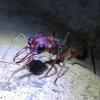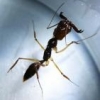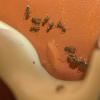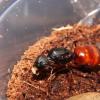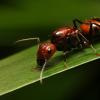I tried on several different occasions. Any ants nesting in soil I never got to the queen. However, I have gotten whole camponotous colonies in logs with a chain saw and wood splitter. Also I caught a mature myrmica sp. colony in a flood. The picture below shows how large the colony was. As you could imagine things got a little messy with ants going everywhere. However I managed to capture most of them. Fairly painful though.

Collecting a wild colony via flooding method is mostly hit or miss, depending greatly on the soil composition and water table in your area. I can't tell you how many times I've observed flooded colonies, and the queen wasn't present in the mass.
My experience is that collecting mature colonies works well when the queen is easy to access, such as in a twig or small branch, under a large rock, under bark, or in a solar mound on a cool spring morning.
The larger the colony, the more difficult it may be to locate the queen, as large colonies are generally more fortified and protected from predators, having been around for years.








